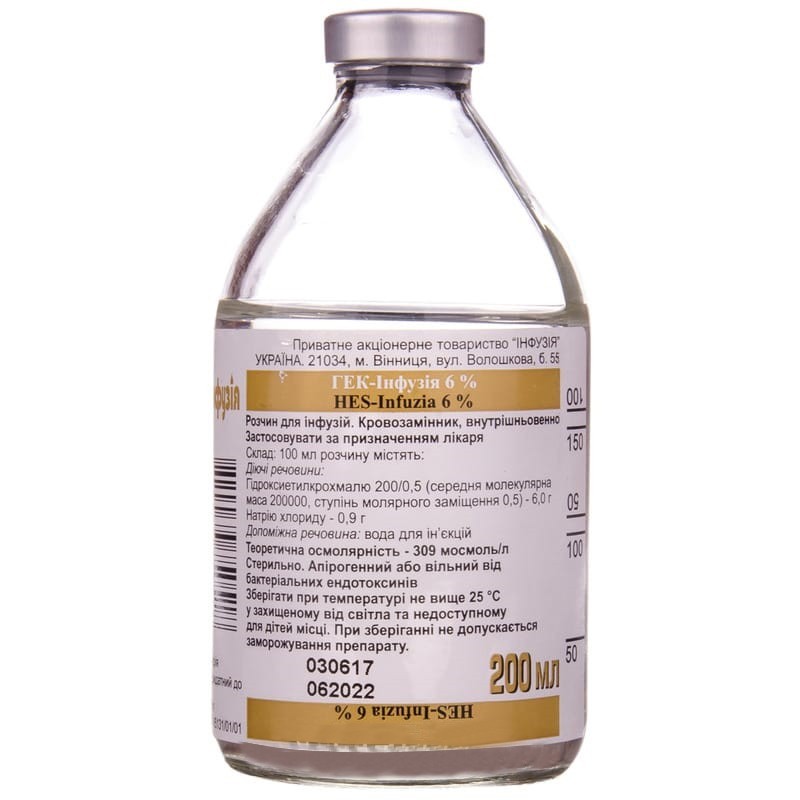



 Secure and encrypted payment processing
Secure and encrypted payment processing We ship to over 40 countries including the USA, UK, Europe, Australia and Japan
We ship to over 40 countries including the USA, UK, Europe, Australia and Japan Guaranteed refund or reship if you haven't received your order
Guaranteed refund or reship if you haven't received your orderHEC-Infusion is indicated for hypovolemia caused by acute blood loss, in cases where the use of crystalloid alone is considered insufficient.
Active ingredient: hydroxyethyl starch;
100 ml of the solution contains: hydroxyethyl starch 200 / 0.5 (average molecular weight 200000, degree of molar substitution 0.5) - 6.0 g or 10.0 g, sodium chloride - 0.9 g;
Excipient: water for injection.
Hypersensitivity to the components of the drug; hypervolemia overhydration; hyperchloremia; severe hypernatremia; a state of dehydration when correction of the water-electrolyte balance is required; chronic heart failure; renal failure, patients with renal replacement therapy, severe liver failure; pulmonary edema; intracranial hemorrhage; severe coagulation disorders of the blood; sepsis; burns; critically ill patients because of the risk of kidney damage and death. Contraindicated in patients with transplanted organs.
The drug is intended for intravenous drip in adults and children from 12 years old. HEC must be prescribed in low effective doses for a short period of time. The dose and rate of administration should be set individually, depending on the condition of the patient, the amount of blood loss and hemodynamic parameters.
The first 10-20 ml of the drug should be administered slowly, carefully monitoring the patients condition, since anaphylactic reactions may develop.
In the treatment of volume deficiency for adults and children from 12 years old, the maximum daily dose of 6% solution is 33 ml / kg body weight, 10% solution - 20 ml / kg body weight. The maximum infusion rate is up to 20 ml / kg / hour, which corresponds to 0.33 ml / kg of body weight per minute.
Treatment should be accompanied by continuous monitoring of hemodynamics, and should be discontinued immediately after reaching appropriate hemodynamic parameters.
It is contraindicated to use the drug in the first trimester of pregnancy, and in the second and third trimesters to use only in cases where the expected benefit from the treatment of the mother outweighs the possible risk to the fetus.
The drug is used for children from 12 years old.
There are no data on the effect of the drug on the reaction rate when driving or working with other mechanisms, since the drug should be used only in a hospital setting.
An overdose or very rapid administration of the drug can lead to volume overload or hypernatremia, which is accompanied by peripheral, interstitial or pulmonary edema and acute heart failure. Excessive administration of chloride can lead to hyperchloremic metabolic acidosis.
Treatment: immediate cessation of infusion, the use of diuretics.
With the simultaneous use of antibiotics of the aminoglycoside group, the drug can enhance their nephrotoxic effect. To prevent incompatibility, it is not recommended to mix the drug with other drugs. Administration of hydroxyethyl starch may cause an increase in serum amylase.
This effect should not be considered as a violation of the function of the pancreas, but as a result of the formation of a complex of hydroxyethyl starch with amylase, followed by a delay in its excretion by the kidneys and non-kidney pathways.
Store at a temperature not exceeding 25 ° C in a dark place and out of the reach of children.
During storage, freezing of the drug is not allowed.
Shelf life is 5 years.